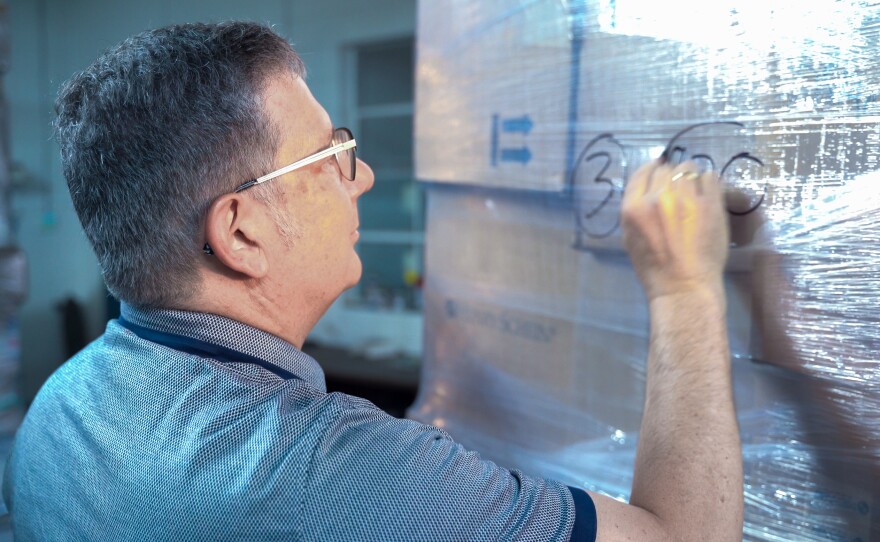Northeast Ohio's Ukrainian American community is undertaking a grassroots effort to address dual threats to their country's future, stemming from Russian attacks on civilian targets and a potential infectious disease outbreak.
Leading this charge is the Cleveland Maidan Association, a Tremont-based humanitarian organization, and its board member Dr. Taras Mahlay, a second generation Ukrainian American who left his job as an internist at University Hospitals to help lead the charge.
“My job is to get supplies,” Mahlay told Ideastream Public Media in an exclusive interview.
And these supplies run the gamut from antibiotics and tourniquets to incubators and ultrasounds, he said.
“Basically everything that’s in a hospital we’re trying to ship,” Mahlay said.
Cleveland Maidan has been obtaining and shipping supplies and equipment even before the Russian invasion last year. Since the invasion started last February, the group has sent more than $3 million in supplies to hospitals throughout the country.
According to Oleg Hray, another Cleveland Maidan board member, no matter how many supplies the group sends, it's not enough. He said this is due to Russian attacks on civilians and civilian targets, including hospitals and other medical facilities.
“They bomb cities, they bomb hospitals, they bomb schools, innocent people,” Hray said. “The amount of supplies, what they need, is always not enough. A couple days ago, one of the hospitals got bombed. We were working with that hospital. That means they get supplies. But tomorrow they might lose those supplies because of rockets from Russia.”

Mahlay said the community is still shouldering much of costs for purchasing and shipping the supplies, despite donations from local medical institutions and others.
In response, the community has hosted fundraisers at Ukrainian festivals across the region. A July event, the Ukrainian Food-Fest held at the Holy Trinity Ukrainian Church in North Royalton, raised more than $54,000. Those funds were used for supplies sent to a hospital in Kherson in southeastern Ukraine. Cleveland Maidan also participated in a festival at the Pokrova Ukrainian Greek Catholic Parish in Parma in early August. The funds raised there will be used for supplies being shipped to a rehab facility in Kharkiv in northeast Ukraine at the end of August.
Mahlay said that despite the ongoing threat from Russian attacks, a potential outbreak of infectious diseases, such as measles, tuberculosis, diphtheria and hepatitis, could prove far more deadly.
“If an epidemic happens, we may have more children dying than have been injured by the war itself,” he said.
According to Dr. William Pewen, a specialist in clinical infectious diseases and biosecurity, ideal conditions exist to cause such outbreaks. He said conditions for a perfect storm of epidemic disease now exist – as infectious threats and low levels of immunization are combined with Russian destruction of hospitals, homes, water, sanitation and power. He noted that under such conditions, new cases of tuberculosis escalated 59% in Ukraine last year.
Pewen said 5.2 million Ukrainians under 15 years of age face particularly high risks.
“Less than 60% of immunizations have been completed for these children. Without a substantial 'catch-up' program, many could suffer the ravages of diseases such as diphtheria, hepatitis and polio," he added.
He also stressed the challenge of immunization during wartime, “The primary imperative must be to expel the invasion, and to treat the victims of trauma. The need to triage is undeniable, but so is the magnitude of the consequences of epidemic disease.”
Pewen said Ukraine’s measles epidemic of 2017-19 caused over 115,000 infections, with thousands more outside its borders. He has advocated an intervention of both response and prevention – providing Ukraine with diagnostics and therapeutics to address outbreaks, while mitigating infection risk by implementing immunization catch-up efforts for children who were missed in previous years. While observing that a full schedule of Ukraine’s childhood immunizations carries a cost of approximately $15, he acknowledged some obstacles.
“The global supply of vaccine is limited, and Ukraine’s access is dependent on donor commitment to fund acquisition for a sufficient catch-up effort,” he said.
He also noted the broader and longer term effects of failing to implement such an outbreak prevention and mitigation strategy, citing the negative impacts of infectious outbreaks spreading to European Union and NATO partners, as well as how epidemic disease would compromise both Ukraine’s recovery and its EU integration.
“Ukraine must win the war, but it must also prevail in peace,” Pewen said.
Mahlay is teaming up with Pewen to head off these threats by advocating for U.S. support for a program of immunization catch-up efforts in Ukraine, while also reaching out to local hospital systems such as University Hospitals, the Cleveland Clinic and MetroHealth for surplus vaccines.
Pewen recounted that a few of his colleagues seemed relieved that a massive catastrophe has not yet ensued, but noted that does not mean the threat is over.
“How long do you think you're going to be lucky?” he added.
Pewen described the cost of combined response and prevention efforts over four years as approximately $97 million – a total equal to less than one-tenth of 1% of the amount of U.S. aid already provided to Ukraine since the February 2022 invasion.
For his part, Mahlay plans to use the distribution infrastructure he's put in place for medical supplies to ensure any vaccines he obtains get where they are needed.
“I'm hoping to approach local hospitals and ask them if you do have a surplus [of vaccines,]" he said. "If they gave it to us, I would ship it. We have the structure."















